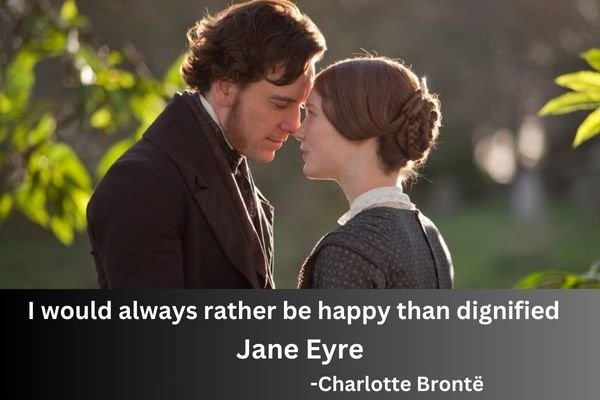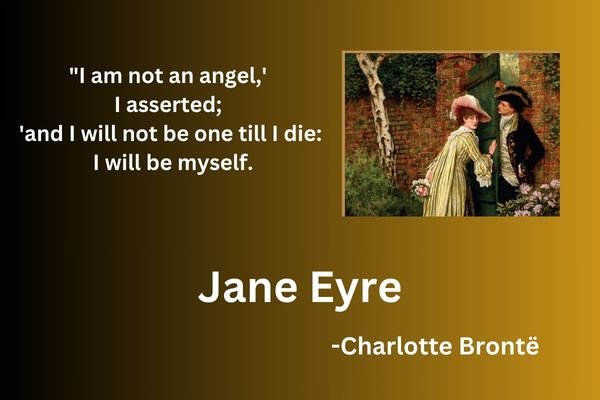Jane Eyre Characters
Jane Eyre:
The novel’s resilient protagonist, an orphan characterized by her strong integrity and independence.
Overcomes challenges at Lowood School and later becomes a governess at Thornfield Hall.
Jane’s journey is marked by moral strength, resilience, and a determined pursuit of personal autonomy.
Edward Rochester:
The enigmatic master of Thornfield Hall, marked by complexity and brooding introspection.
His mysterious past and evolving relationship with Jane form a central theme, adding layers to the narrative.
Rochester’s struggles with personal demons contribute to the novel’s emotional depth.
Bertha Mason:
Rochester’s first wife, concealed within Thornfield Hall.
Bertha’s presence becomes both haunting and pivotal, raising questions about societal expectations, mental health, and colonialism.
St. John Rivers:
A clergyman with significance in Jane’s life, representing duty and societal norms.
His character contrasts with Jane’s quest for emotional fulfillment, delving into themes of religion, morality, and individual choices.
Helen Burns:
Jane’s friend at Lowood School, known for her serene acceptance of hardship.
Helen’s influence on Jane contributes to the novel’s exploration of morality and spirituality.
Mrs. Reed:
Jane’s harsh aunt at Gateshead, symbolizing societal expectations and mistreatment of orphans.
Mrs. Reed’s treatment shapes Jane’s resilience and fuels her quest for independence.
Bessie Lee:
A maid at Gateshead who shows kindness to Jane during her early years.
Bessie’s compassionate actions stand in stark contrast to the mistreatment Jane experiences from other members of the Reed family.
Mr. Brocklehurst:
The strict headmaster of Lowood School, embodying austerity and rigid religious interpretations.
His character symbolizes the oppressive nature of certain educational and religious ideologies.
Miss Temple:
A compassionate teacher at Lowood who serves as a positive influence on Jane.
Miss Temple represents a more benevolent and nurturing aspect of the educational system.
Adele Varens:
A young French ward under Rochester’s care at Thornfield Hall.
Adele’s presence adds complexity to the relationships within the household.
Grace Poole:
The mysterious and seemingly eccentric servant at Thornfield Hall.
As the novel progresses, Grace Poole’s role becomes clearer, unveiling secrets within the household.
Charlotte Brontë’s adept portrayal of these characters, with their intricate nuances and complexities, enriches the exploration of themes such as social class, morality, and the pursuit of personal identity. The characters in “Jane Eyre” collectively contribute to the enduring allure of the novel, establishing it as a classic that resonates with readers across generations.
Jane Eyre Summary

“Jane Eyre” by Charlotte Brontë stands as a timeless classic, a narrative tapestry interwoven with themes of passion, morality, and the societal constraints of its era. The novel traces the journey of its resilient and independent protagonist, Jane Eyre, through a world marked by adversity, love, and an unwavering quest for personal identity.
The story commences with Jane’s challenging childhood. Orphaned and mistreated by her aunt, Mrs. Reed, at Gateshead Hall, Jane’s spirit remains unbroken. Her fortitude attracts the attention of Mr. Lloyd, a compassionate apothecary, who recommends her placement at Lowood School. Despite the hardships at Lowood, Jane forges deep connections, particularly with her friend Helen Burns and the nurturing Miss Temple.
Upon completing her education, Jane takes up a position as a governess at Thornfield Hall, where she encounters the enigmatic Mr. Rochester. The evolving relationship between Jane and Rochester becomes the nucleus of the narrative, fraught with tension, secrets, and the revelation of concealed pasts. The presence of Rochester’s ward, Adele, adds complexity to their interactions, and Jane’s character undergoes transformation amid the challenges at Thornfield.
As Jane and Rochester’s relationship deepens, a mysterious and unsettling figure emerges in the form of Bertha Mason, Rochester’s first wife. The disclosure of Rochester’s troubled past and the shocking truth about Bertha presents a moral dilemma for Jane. Faced with conflicting emotions and a commitment to her principles, Jane makes a courageous decision, leaving Thornfield and embarking on a new phase of her life.
Jane’s journey leads her to Moor House, where she encounters the Rivers siblings—St. John, Diana, and Mary. The Rivers family offers Jane a sense of belonging and purpose, but St. John’s proposal of a pragmatic yet loveless marriage tests her resolve. Jane’s refusal to compromise her principles for societal expectations underscores her unwavering integrity.
The narrative takes a dramatic turn when Jane learns of Rochester’s tragic fate. Compelled by love, she returns to Thornfield to find Rochester physically and emotionally scarred by the consequences of his past. The reunion of Jane and Rochester becomes a poignant moment of redemption and forgiveness, highlighting the enduring power of genuine love.
Charlotte Brontë employs vivid imagery and rich symbolism to enhance the thematic depth of “Jane Eyre.” Thornfield Hall, with its gloomy and imposing structure, serves as a metaphor for the emotional obstacles Jane must overcome. The mysterious and haunting atmosphere surrounding Bertha Mason becomes a reflection of societal expectations and the repercussions of suppressed desires.
Jane Eyre herself emerges as a literary triumph. Her journey from an orphaned child enduring hardship to a self-assured woman making choices based on principles showcases Brontë’s exploration of feminist themes and the pursuit of autonomy. Jane’s moral compass, intellectual curiosity, and emotional resilience make her a captivating and relatable protagonist.
“Jane Eyre” also delves into broader societal issues, including class disparity, gender roles, and the limitations placed on women in the 19th century. Brontë challenges societal norms through Jane’s assertiveness, independence, and refusal to conform to restrictive expectations.
In conclusion, “Jane Eyre” is a literary masterpiece that transcends time, weaving a narrative that probes the complexities of human relationships, moral quandaries, and the indomitable spirit of its protagonist. Charlotte Brontë’s masterful storytelling, coupled with the depth of characters and exploration of societal themes, has solidified “Jane Eyre” as a classic that resonates with readers globally.
Read Also : “Unveiling the Enigmatic Tale: A Captivating Wuthering Heights Summary”
